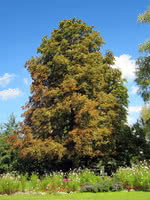Mon-Fri 9am - 5pm Mountain time
Horse Chestnut vs Bebbs Willow
Aesculus hippocastanum
Salix bebbiana
CUSTOM GROW
Horse Chestnut is a medium sized deciduous tree that is native to Greece but has been grown in North America for hundreds of years. It produces large nuts.
A top CO2 absorbing species. Experts think this tree may help climate change more than others.
This large shrub is native to all of Canada and most of the United States. Its leaves are green on the top and grey on the bottom, and it produces catkin based flowers and non-edible fruit which appears very similar to a group of pine needles.
Bebb's Willow is foraged for by many species including elk, hares, beavers and various birds. It is commonly used to prevent erosion and protect aquatic environments due to its preference for shady, moist environments.
Horse Chestnut Quick Facts
Bebbs Willow Quick Facts
Toxicity: most parts of plant are toxic

